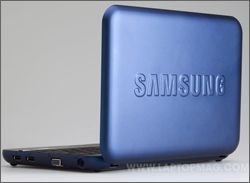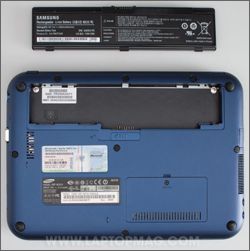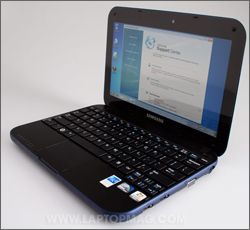Laptop Mag Verdict
If you're set on purchasing a 3G netbook, you can find better performance and battery life elsewhere for the same price.
Pros
- +
Compact, stylish design
- +
Responsive, fairly large touchpad
- +
Good Wi-Fi performance
Cons
- -
Very short battery life
- -
Slow boot time
- -
Below-average performance
Why you can trust Laptop Mag
It's hardly a secret that we're not too keen on netbooks with integrated 3G broadband. In exchange for paying about $100 less up front, you're making a commitment to spend between $840 and $1,440 for monthly data charges over two years for something that's not going to be your primary PC. However, if you think the always-on connectivity--as well as that $199 price--are appealing, take note that some subsidized netbook deals are sweeter than others. The Samsung Go through AT&T is not one of those deals. While we liked the unsubsidized version of this netbook, the one that AT&T sells has a smaller battery, and doesn't last nearly as long on a charge. For the same price, you can find other netbooks that perform better and last longer.
Design
From its rounded edges to its midnight blue rubberized lid, the Go has a fresher, more fashion-forward design than many other netbooks we've seen. The lid feels at once softer and more durable than other netbooks. However, it has Samsung's logo embossed in huge capital letters, which some may find off-putting. On the inside, Samsung did a good job of designing an island-style keyboard while still giving the user plenty of room to type (it helps that there's little space on either end of the keyboard).
In addition to its soft, rubbery finish and contoured shape, we quickly warmed to the Samsung Go simply on account of how light it feels. At 2.6 pounds, this system is light, even for a netbook. At 10.3 x 7.3 x 1.1 inches, it's smaller than the Lenovo IdeaPad S12 with Ion, as well as most netbooks.
Keyboard and Trackpad
We enjoyed both the attractive design and comfortable feel of the Go's island-style keyboard. However, compared to the Toshiba mini NB205, whose metal keyboard remains the best we've ever seen on a netbook, the Go's layout feels more cramped, and sounds noisier. And yet, using the Ten Thumbs Typing Tutor test as a benchmark, we were able to type 81 words per minute. That's pretty respectable, given that we've reached 88 wpm on a full size desktop keyboard.
We like that the Samsung Go has a fairly large touchpad (2.5 x 1.5 inches). However, we wish this netbook had two discrete touch buttons instead of a single touch bar. That said, this bar was easy to press and provided good tactile feedback. We'd like it more if it were just a bit wider; at only half an inch thick, it was sometimes difficult even for our narrow fingers to settle on.

Click to enlarge
Display and Sound

Click to enlarge
While the 10.1-inch (1024 x 600) display was easy to view from the sides, the picture became washed out as soon as we started to dip the screen toward us as you would while, say, riding an airplane. When we watched a full-screen YouTube clip of The Muppets singing "Bohemian Rhapsody," the video stuttered somewhat, and didn't always sync up with the audio. Still, the hiccuping was subtle enough that it didn't stop us from enjoying the clip (more on this in the graphics section).
On the plus side, the Queen song didn't sound too tinny coming through the speaker strip above the keyboard. However, audio wasn't loud enough, even at its maximum volume.
Ports and Webcam
The Go includes the typical netbook selection of ports: three USB, VGA, a 3-in-1 memory card slot, headphone and mic ports, and an Ethernet jack, which is covered by a plastic door.

Click to enlarge

Click to enlarge
As for the 1.3-megapixel webcam, the color and brightness were both particularly dim, but we enjoyed the CyberLink YouCam software, which has plenty of fun filters and an intuitive UI that stores all of your recent captures in a pane along the right-hand side.
Performance
The Go, like many netbooks, comes equipped with a 1.6-GHz Intel Atom N270 processor, 1GB of RAM, and Windows 7 Starter Edition, a watered-down version of Windows designed specifically for netbooks (for example, you can't customize the desktop background in this version). These components notched a score of 1,242 on PCMark05 and 819 on Geekbench, both of which are benchmarks that measure a notebook's overall performance. These scores are below the netbook category averages of 1,498 and 833, respectively.
The 5,400-rpm, 160GB hard drive transferred a 4.97GB mixed media folder at a rate of 17.1 MBps, which is faster than the netbook category average of 15.4 MBps. However, it took the Samsung Go a sluggish 70 seconds to boot Windows 7 Starter Edition (the average netbook takes 57 seconds).
In our hands-on testing, we found the Go's performance adequate for casual, time-limited use. We were able to download Java while loading our Twitter feed and a YouTube clip in separate tabs. However, we experienced some trouble switching from tab to tab; we often had to wait a few seconds for the netbook to fully transition. When we transcoded a five-minute-and-five-second MPEG-4 clip to AVI (granted, something netbooks were not intended to do), it took 34:56, whereas the average netbook takes a faster 29:42.
Graphics
That stuttering YouTube clip didn't exactly give us a good first impression of the Go's graphics performance. In fact, its integrated Intel GMA 950 graphics notched just 132 on 3DMark06, which is about 30 points below average (160). However, it marks a strong improvement over the Windows XP Go (not sold through AT&T), whose score was 88. Netbooks with discrete Ion graphics, such as the HP Mini 311, not only score higher on this test (the 311 got 1,386), but they play high-def video more smoothly.
3G Wireless

Click to enlarge
Of course, what makes this version of the Samsung Go different from the unlocked version is that for $199 (plus monthly data charges) you get access to AT&T's 3G network. It costs $35 per month if you go with the 200MB plan, but the more practical 5GB plan (particularly if you like to go to bandwidth-heavy sites such as YouTube) costs $60 per month. In addition to allowing for a more realistic amount of data per month, the 5GB plan includes a charge of 5 cents for every megabyte you go over the limit; with the 200MB plan, that overage charge is 10 cents per megabyte.
Using Speedtest.net, we tested AT&T's 3G network's speeds from within our Manhattan office. We saw an average download speed of 1.1 Mbps, and an average upload speed of 170.0 Kbps (or about 0.2 Mbps). That download speed isn't quite as fast as the HP Mini 311 on Verizon Wireless' network, which fell between 1.2 and 1.3 Mbps. Its upload speeds were slower, too; the Mini 311 hovered between 500 and 600 Kbps (or, about 0.6 Mbps).
Anecdotally, our connection over AT&T was relatively slow. Even though we had all but one bar of service, it still took 15 seconds to load ESPN.com, 40 seconds to load Laptopmag.com, and 23 seconds to load NYTimes.com. The HP Mini 311, meanwhile, loaded the same sites in 16, 11, and 11 seconds, respectively.
Battery Life and Wi-Fi
While the first Samsung Go unit we tested had a six-cell battery that lasted 8:23 on a charge, the version sold through AT&T comes with a smaller four-cell battery, which delivers much shorter battery life. With Wi-Fi enabled, this Go lasted just 2:47 on our Web surfing test; that time dropped to 2:42 once we logged on using 3G instead.
While it's nice to know the 3G connectivity doesn't seem to significantly affect battery life, less than three hours for a netbook is unacceptable, especially when the average one lasts over five hours. Having always-on connectivity might make a netbook more mobile, but this smaller battery certainly counteracts that. AT&T would have a much stronger product if it sold the Go with a six-cell battery, offering both ubiquitous Internet access and long battery life.
The Go's wireless 802.11b/g radio delivered throughput of 19.6 Mbps and 13.1 Mbps at 15 and 50 feet, respectively. While that's weaker than the average (20.8 and 17.1 Mbps), we found that even in an apartment where three laptops were already competing for bandwidth from our wireless-G router, the Samsung Go held its own; we didn't experience any pauses while streaming a five-minute YouTube clip.
Energy Efficiency
The Go took 1:14 to charge to 80 percent, and 2:13 to completely recharge. During this time, it consumed a total of 4096.4 watts. By dividing the battery life by the total watts, we were able to derive the LAPTOP Battery Efficiency Rating, which came out to 24.5 (lower scores are better in this case). Given that the average netbook we test has an energy efficiency index of 16.8, that's not terribly green. However, the Go's EPEAT rating is 21 (out of 27), which is good.
Software, Configurations, and Warranty

Click to enlarge
The Go's bundled software includes a 60-day trial of Microsoft Office Home and Student 2007; Microsoft Works 9.0, the free word processor; CyberLink YouCam; a 60-day trial of McAfee Internet Security 9.0; Windows Live Applications; AT&T Communications Manager; Adobe Acrobat Reader; Windows Media Player 11; and Adobe Flash Player.
AT&T offers no additional configurations of the Go.
The Go comes with a one-year warranty, including 24/7 toll-free phone support.
Verdict
Although we initially liked the $449 Samsung Go (which includes a six-cell battery), we're not nearly as fond of the $199 version sold through AT&T, whose four-cell battery doesn't even last three hours on a charge. What's more, for the same price you can get the HP Mini 311 from Verizon Wireless, which performs better, lasts nearly five hours on a charge via Wi-Fi, and, thanks to its Nvidia Ion graphics, delivers a stronger multimedia experience. If you like the idea of built-in 3G wireless, skip the Go.
Samsung Go N310 Specs
| Brand | Samsung |
| CPU | 1.6-GHz Intel Atom N270 |
| Card Slots | 3-1 card reader |
| Company Website | http://www.wireless.att.com |
| Display Size | 10.1 |
| Graphics Card | Intel GMA 950 |
| Hard Drive Size | 160GB |
| Hard Drive Speed | 5,400rpm |
| Mobile Broadband | AT&T 3G |
| Native Resolution | 1024x600 |
| Operating System | MS Windows 7 Starter Edition (32-bit) |
| Ports (excluding USB) | VGA, Microphone, Headphone, Ethernet |
| RAM | 1GB |
| RAM Upgradable to | 1 GB |
| Size | 10.3 x 7.3 x 1.1 inches |
| USB Ports | 3 |
| Video Memory | Shared |
| Warranty/Support | One-year limited parts-and-labor/24/7 toll-free phone |
| Weight | 2.6 pounds |
| Wi-Fi | 802.11b/g |
